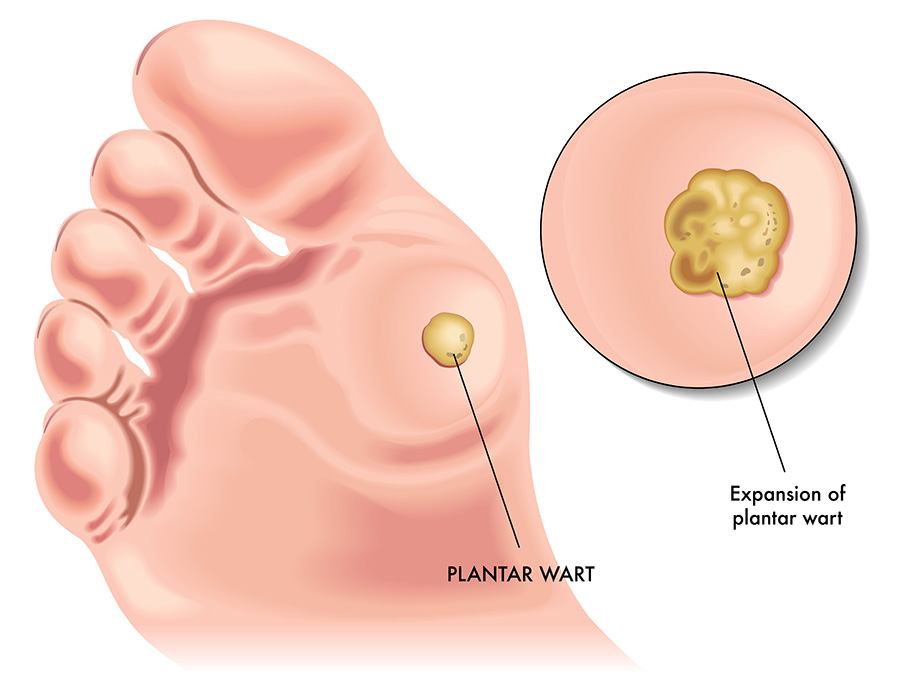Top 11 Things to Know About Plantar Warts

Plantar warts, sometimes called seed warts, are painful warts that often show up on the soles or bottom of the foot. They are noncancerous in nature and affect the top layer of the skin. Sometimes, people mistakenly call calluses or corns plantar warts, though they are not at all the same ailment. The following is more information about the often painful condition of plantar warts:
Top Eleven Things to Know About Plantar Warts
1.) They Are Caused By a Virus: As is the case with warts found in other locations of the body, plantar warts are also caused by the HPV, or human papillomavirus. Though you can come into contact with this virus virtually anywhere, swimming pools, locker rooms, shower floors and other moist, warm locations are prime spots to contract HPV. In addition, contrary to many folk tales of old, a person doesn’t get a wart after touching a toad.
2.) Plantar Warts Are So Named Due to Their Location: Plantar warts are so named because they located on the bottom of the foot, also called the plantar region.
3.) Warts Can Spread: In some case, one plantar wart will appear on the sole of the foot then spread to another area of the foot. They can also increase in size and have offshoots or baby warts that resemble a wart mosaic. This is, of course, incredibly painful.
4.) Plantar Warts Don’t Really Have Seeds: Plantar warts are sometimes referred to as seed warts. However, the idea of them having “seeds” is really a misconception. Instead, inside the wart, you can see the end of the blood vessel capillaries. It looks like small “seeds” within the wart, hence the misconception.
5.) Plantar Warts Tend to be Flat: Unlike other types of warts located in various locations on the body, plantar warts aren’t raised away from the skin as much. This is likely due to the fact that they are pushed down due to the weight of the body.
6.) Plantar Warts Will Eventually Go Away on Their Own: You might be tempted to wait out your plantar warts until they heal on their own. Though this is an option, it can take some time for them to fade away, and you do risk them spreading to other parts of your foot in the meantime. Therefore, many people opt for some type of treatment for the often painful condition.
7.) Most People Begin By Treating Plantar Warts With Over-The-Counter Medication: There are many home remedies and over-the-counter treatment solutions for plantar warts. Lotion, ointment and/or gel with salicylic acid are designed to peel the wart away. There are also freezing sprays you can buy over-the-counter that are designed to kill the wart tissue. Experts feel these remedies work only about half the time, and if you are experiencing a painful plantar wart, you likely want relief now rather than later.
8.) Doctor’s Treatments Are The Best Course of Action: When it comes to plantar warts, they can be extremely troublesome to fight away. This often means you have to employ the help of a podiatrist like the professionals at Red Mountain Footcare to diagnose and treat your plantar wart effectively. A podiatrist will carefully remove excess skin from the wart, then apply a treated dressing. They will sometimes also advise patients to apply salicylic acid. If the wart doesn’t respond to this treatment, your podiatrist will often remove it surgically in-office or use liquid nitrogen to freeze the wart and dissolve it. The following are a few ways to know it’s time to go see a podiatrist and stop trying to treat your plantar wart yourself:
- You aren’t sure what you have is a plantar wart. As mentioned above, sometimes, plantar warts are confused for other foot conditions like calluses.
- You currently have a weakened immune system due to HIV/AIDS, immune-suppressing drugs or other immune system disorders.
- You have poor sensation in your feet and/or diabetes.
- You are finding yourself unable to take part in all activities due to your discomfort.
- You have tried to treat the plantar wart yourself and either it isn’t responding to treatment at all or it keeps recurring.
- You have noticed changes in the appearance of the wart, it is painful or bleeding.
9.) Most Plantar Warts Form on The Balls of The Feet or The Heels: Although plantar warts can occur anywhere on the bottom of the foot, most people get them on the balls of their feet or their heels. This is because these areas have the most pressure applied to them during normal walking and standing.
10.) There Are Some People More Susceptible Than Others to Plantar Warts: Anyone can get a plantar wart, but there are some demographics who are more susceptible than others and they are listed below:
- Anyone who walks barefoot in locker rooms and other similar locations that harbor HPV.
- Anyone who has ever had a plantar wart before. Once you have had one, you are more susceptible to getting additional warts.
- Anyone whose immune system is compromised or weakened.
- Anyone who is considered a child or teenager.
11.) There Are Some Ways to Make Yourself Less Likely To Get a Plantar Wart: There are some things to remember in order to avoid having to endure this painful condition and they are listed below:
- Change your socks often or using foot powders to reduce moisture.
- Wear sandals or thongs when using a public shower or locker room in order to reduce your risk of contracting HPV. Never go barefoot around a public pool or in a public shower or locker room.
- Don’t use the same nail clippers, pumice stone or emery board on healthy nails and skin as you do on your wart. This will cut down on the risk of spreading.
- Don’t scratch or pick at warts.
- Don’t come into contact with warts if at all possible. If you have to touch a wart to apply treatment, make sure you wash your hands extremely well.
The above are eleven top things to know about plantar warts. If you think you are experiencing this painful foot condition, contact the professionals at Red Mountain Footcare to learn more about treatment options.
Another Interesting Article You Might Like: Treatment For Plantar Warts
